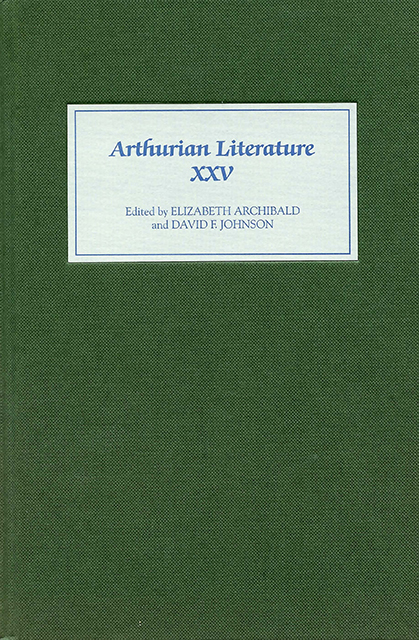Book contents
- Frontmatter
- Contents
- Illustrations
- Foreword
- Contributors
- Abbreviations
- I Geoffrey of Monmouth and the Merlin Legend
- II The Enchantress, The Knight and the Cleric: Authorial Surrogates in Arthurian Romance
- III ‘Morgan Le Fay, Empress of the Wilderness’: A Newly Recovered Arthurian Text in London, Bl Royal 12.C.IX
- IV Malory's Lancelot and the Key to Salvation
- V Chrétien in Ivory
- VI ‘An Empire of Itself’: Arthur as Icon of an English Empire, 1509–1547
II - The Enchantress, The Knight and the Cleric: Authorial Surrogates in Arthurian Romance
Published online by Cambridge University Press: 10 March 2023
- Frontmatter
- Contents
- Illustrations
- Foreword
- Contributors
- Abbreviations
- I Geoffrey of Monmouth and the Merlin Legend
- II The Enchantress, The Knight and the Cleric: Authorial Surrogates in Arthurian Romance
- III ‘Morgan Le Fay, Empress of the Wilderness’: A Newly Recovered Arthurian Text in London, Bl Royal 12.C.IX
- IV Malory's Lancelot and the Key to Salvation
- V Chrétien in Ivory
- VI ‘An Empire of Itself’: Arthur as Icon of an English Empire, 1509–1547
Summary
Introduction
The clerics who composed historical works and vernacular romances in the twelfth and thirteenth centuries frequently figured themselves as authors and as clerks within their texts. Their self-depictions could vary widely, from the jongleurs (one eponymously named Juglet) in the work of Jean Renart and Gerbert de Montreuil, to the hermit, chosen by Christ, or the confessor-priest in the Lancelot-Grail Cycle, to the enchantress or magician, epitomized by Merlin himself. Insular historians, as David Rollo has argued in Glamorous Sorcery, point up for their varying audiences – the literate and the not-so-literate – the possibility that their texts include both fact and fiction, truth and artifice, that fabula, often concealing a deeper kind of truth, may be at work in such texts as William of Malmesbury’s Gesta regum Anglorum or Gerald of Wales's Topographia and Expugnatio Hibernica. The clerical historian, Rollo suggests, calls attention to his artifice by consistently evoking
[a] surrogate author projected as magician and the written medium he controls designated through a lexicon that collapses the verbal arts with glamorous sorcery (gramaire/grimoire), performative conjuring (praestigia), intoned spells (incantationes), and drugs capable of seducing, bewitching, transforming, or curing those to whom they are administered (medicamenta/medicamina).
In his consideration of Benoît de Sainte-Maure's self-presentation in the Roman de Troie, and more so in his concluding remarks about Chrétien’s Cligés, Rollo expands the domain of the author-magician figure from chronicle into twelfth-century romance. Chrétien, he maintains, aims to enact a generic separation between history and romance in Cligés by presenting ‘his own artifice as a form of creative necromancy’. Taking my departure from the arguments of Rollo and Michelle Freeman, and engaging with the work of Jane Burns and Miranda Griffin on authors and authority in the Lancelot-Grail Cycle, in this essay I explore the authormagician identification in Arthurian romance in both France and England. I will analyse magical figures, including Merlin and his enchantress pupils, who operate as authorial surrogates in using transformation, illusion and artifice within courtly fiction. They not only stage and direct local narratives in which they figure, but also gesture towards and comment on deeper truths about chevalerie, critically considered from the standpoint of clergie.
- Type
- Chapter
- Information
- Arthurian Literature XXV , pp. 43 - 66Publisher: Boydell & BrewerPrint publication year: 2008
- 1
- Cited by



